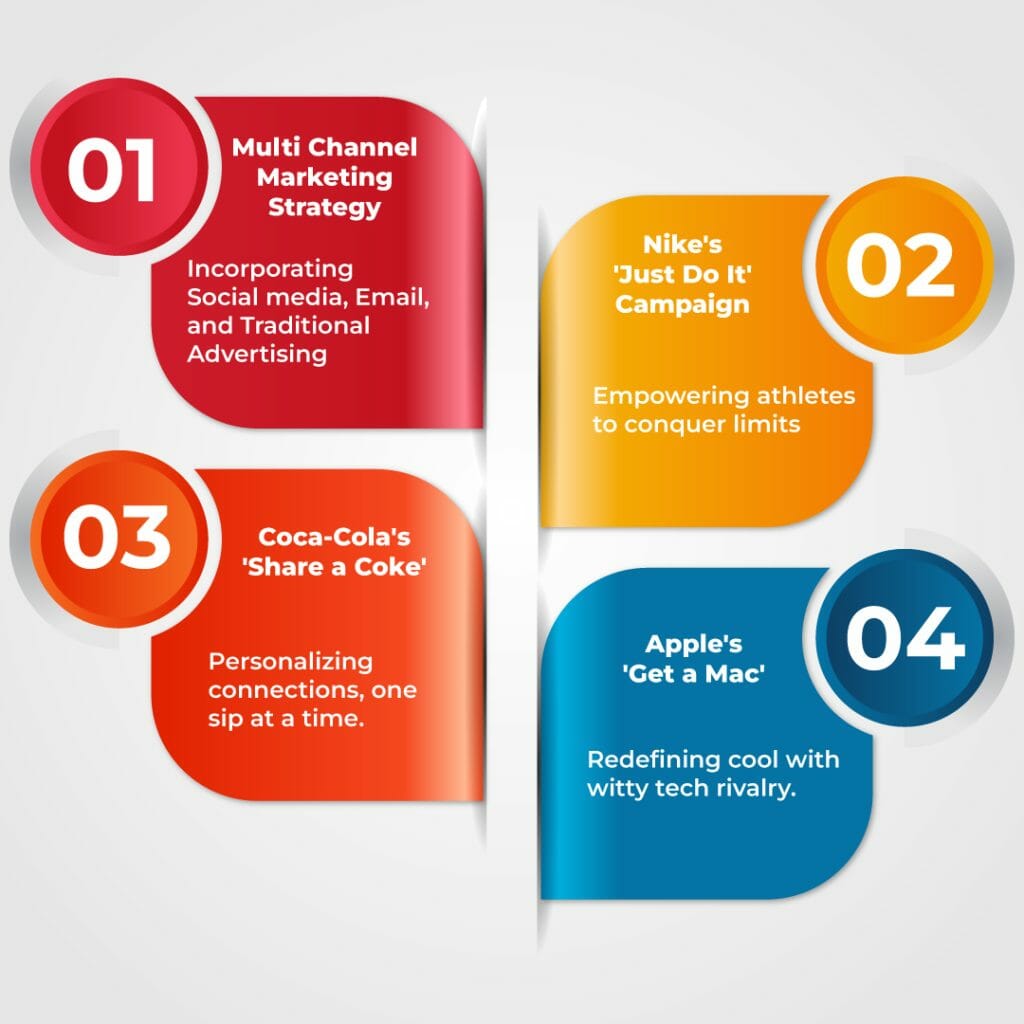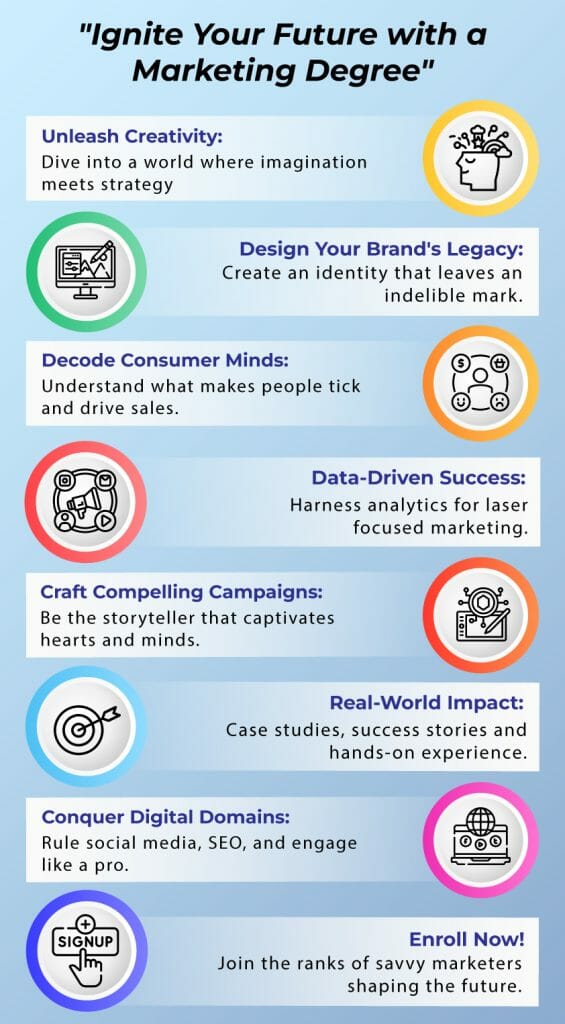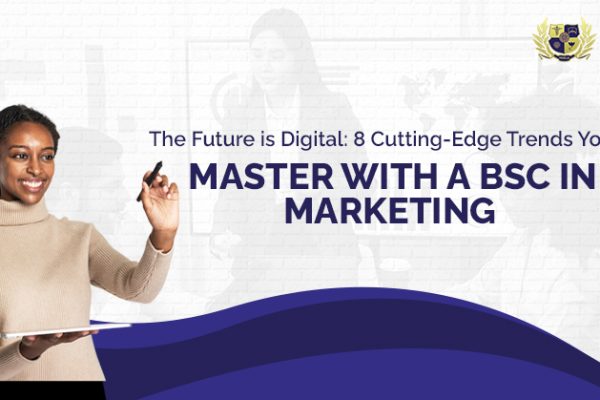|
Tired of Reading? Please listen to the blog
|
Key Takeaways
In this comprehensive guide, we delve into the core principles of successful marketing strategies, providing invaluable insights for both students and professionals in the field. We begin with an exploration of the significance of sales growth in business, emphasizing its pivotal role in achieving organizational success. We then introduce the powerful concept of leveraging a marketing degree, highlighting its instrumental role in implementing effective strategies.
Understanding consumer behavior takes center stage as we delve into the psychology behind consumer decisions. We uncover how consumer behavior directly influences purchasing choices and delve into essential market research techniques for a deeper understanding. In the digital age, leveraging platforms is crucial, and we guide readers through mastering social media marketing and employing effective strategies. Building engagement and brand loyalty is at the forefront, along with optimizing search engine visibility through SEO techniques. Building strong brand identities is an integral part of successful marketing, and we examine the art of crafting compelling brand stories that forge emotional connections. Real-life examples of effective brand storytelling serve as inspiration, along with insights into designing memorable visual identities.
In the conclusion, we recap the five proven strategies and emphasize the significant impact a marketing degree can have in implementing these techniques. This guide serves as a comprehensive roadmap for mastering marketing, equipping readers with the knowledge and skills to excel in this dynamic field.
Introduction:
Introducing the concept of leveraging a marketing degree for implementing successful strategies is akin to opening a door to a realm of boundless potential and transformative impact. It is about harnessing the power of education to not only understand the intricacies of consumer behaviour and market dynamics but to strategically apply this knowledge in ways that drive sales to unprecedented heights. A marketing degree is more than a credential; it is a comprehensive toolkit that equips individuals with the skills, insights, and strategic mindset needed to thrive in the dynamic world of commerce.
Beyond the confines of textbooks, a marketing degree program immerses students in a world of practical applications, case studies, and hands-on experiences. It encourages critical thinking, creativity, and an acute awareness of emerging trends. It cultivates the ability to dissect market trends, identify consumer needs, and craft compelling narratives that resonate with target audiences. This comprehensive approach fosters marketers who are not only well-versed in theory but adept at navigating the fast-evolving landscape of contemporary business.
In the following sections, we will delve into five battle-tested strategies, each an embodiment of the knowledge imparted by a Bachelor of Science in Marketing program. These strategies are not isolated tactics, but rather extensions of a comprehensive education that empowers marketers to navigate the complexities of today’s competitive markets. Together, they form a cohesive framework that not only elevates sales figures but also cultivates a culture of innovation and adaptability. So, let us embark on a journey through these strategies, understanding how they synergize with a marketing education to not just meet business objectives, but to surpass them, driving success to new horizons.
Brief overview of the significance of sales growth in business.
Sales growth is the lifeblood of any business, serving as a vital indicator of its overall health and prosperity. It goes beyond mere monetary transactions; it embodies the heartbeat of an enterprise, reflecting its ability to connect with customers, meet their needs, and deliver value. A thriving sales department is akin to the engine that propels a business forward, driving revenue, fuelling innovation, and enabling expansion.
A steady and sustained increase in sales is not just a measure of financial success; it signifies a company’s relevance and competitiveness in a dynamic market. It demonstrates that a business is not only meeting current demands but also anticipating and adapting to future trends. This growth is a testament to a company’s ability to effectively market its products or services, outshine competitors, and resonate with its target audience.
Moreover, sales growth is instrumental in creating a positive feedback loop within an organization. It fosters a culture of achievement and motivation among sales teams, instilling a sense of purpose and pride in their contributions. This, in turn, translates into a more engaged and productive workforce, as employees see the direct impact of their efforts on the company’s success.
From a financial perspective, robust sales growth can enhance a company’s valuation and attractiveness to investors. It provides the resources needed for research and development, innovation, and expansion into new markets. Additionally, increased sales can lead to economies of scale, potentially reducing production costs and improving profit margins.
In today’s fast-paced business landscape, characterized by rapid technological advancements and evolving consumer preferences, sales growth is not merely a goal—it is a strategic imperative. It represents a company’s ability to adapt, innovate, and stay ahead of the curve. It is a testament to its agility in responding to market shifts, its proficiency in leveraging emerging trends, and its commitment to customer-centricity.
In essence, sales growth is the heartbeat of a business, pulsating with vitality, resilience, and promise. It fuels the engine of progress, propelling a company towards new heights of success and sustainability. In the pages that follow, we’ll explore five proven strategies that, when coupled with the power of a Bachelor of Science in Marketing, can amplify this heartbeat, setting the stage for unprecedented growth and prosperity.
Introduce the concept of leveraging a marketing degree for implementing successful strategies.
Introducing the concept of wielding a marketing degree as a catalyst for implementing highly effective strategies is akin to unlocking a treasure trove of knowledge, skills, and insights. It is not just a piece of paper; it is a gateway to a world where theory meets practice, where classroom learning intersects with real-world application, and where ideas morph into impactful campaigns that drive sales and foster business growth.
A marketing degree is not merely an academic pursuit; it is a transformative journey that equips individuals with a nuanced understanding of consumer behaviour, market dynamics, and the art and science of persuasion. It empowers aspiring marketers with a repertoire of tools, methodologies, and best practices honed through rigorous coursework and hands-on experiences. It is a passport to a domain where creativity meets strategy, and where innovation is cultivated to forge connections with target audiences.
By delving into the realms of market research, consumer psychology, and strategic planning, a marketing degree lays the foundation for crafting campaigns that resonate with consumers on a profound level. It imparts the ability to not only identify consumer needs and desires but also to anticipate them, enabling businesses to stay ahead of the curve and lead rather than follow in their respective industries.
Moreover, a marketing degree program is a breeding ground for innovation and out-of-the-box thinking. It encourages students to challenge conventional wisdom, explore new avenues, and experiment with emerging technologies and platforms. This dynamic environment fosters the development of forward-thinking marketers who are not only adept at adapting to change but also at driving it.
In the pages that follow, we will embark on a journey through five battle-tested strategies, each a manifestation of the knowledge and skills imparted by a Bachelor of Science in Marketing program. These strategies are not isolated concepts; they are extensions of a comprehensive education that arms marketers with the ability to navigate the complexities of the modern business landscape.
So, as we dive into the specifics of these strategies, keep in mind that they are not standalone tactics. They are threads woven into the fabric of a holistic marketing education, each contributing to a tapestry of proficiency that empowers marketers to not only meet but exceed their goals. Let us explore how the fusion of education and application can culminate in strategies that do not just drive sales but propel businesses to unparalleled heights of success.

Understanding Consumer Behaviour
Importance of Consumer Behaviour in Marketing
Understanding consumer behaviour is the cornerstone of any successful marketing strategy, providing businesses with invaluable insights into the preferences, motivations, and decision-making processes of their target audience. This knowledge allows marketers to tailor their products, services, and messaging in a way that resonates deeply with consumers, increasing the likelihood of conversion and brand loyalty.
Consumer behaviour encompasses a wide range of factors, including psychological, social, and cultural influences. It delves into why consumers make certain choices, how they perceive brands, and what drives their purchasing decisions. By dissecting these elements, businesses can develop marketing campaigns that strike a chord with their audience on a personal level.
Moreover, recognizing the importance of consumer behaviour enables businesses to adapt and innovate in response to shifting market dynamics. In the pages that follow, we will explore how a marketing degree equips individuals with the tools to not only grasp the intricacies of consumer behaviour but to leverage this knowledge effectively in crafting compelling marketing strategies.
Exploring the psychology behind consumer decisions
Understanding the psychology behind consumer decisions delves into the intricate workings of the human mind when making purchasing choices. It involves dissecting factors such as emotional triggers, cognitive biases, and subconscious influences that play a pivotal role in shaping buying behaviour. By uncovering these underlying motivations, marketers can craft messaging and offers that resonate on a profound level with consumers, creating a sense of alignment and connection. This deeper understanding allows businesses to not only meet surface-level needs but to tap into the emotional resonance that drives brand loyalty and sustained customer relationships.
How Consumer Behaviour Influences Purchasing Choices
Consumer behaviour exerts a profound influence on purchasing choices, dictating the products individuals select and the brands they prefer. It encompasses a spectrum of factors, from personal preferences and lifestyle to cultural influences and social interactions. Understanding these dynamics empowers marketers to align their offerings with the prevailing sentiments and desires of their target audience. By acknowledging the pivotal role consumer behaviour plays in decision-making, businesses can tailor their strategies to address specific needs, cultivating a stronger rapport with their clientele. This insight serves as a compass, guiding marketing efforts towards strategies that resonate and result in increased sales and brand loyalty.
Market Research Techniques for Understanding Consumer Behaviour
Market research techniques for understanding consumer behaviour encompass a diverse toolkit of methodologies aimed at unravelling the intricacies of buyer preferences. This includes surveys, focus groups, observational studies, and data analytics, among others. These techniques provide valuable quantitative and qualitative insights into consumer motivations, purchasing habits, and the influences that shape their decisions.
By employing a combination of these approaches, businesses can gain a comprehensive understanding of their target audience, allowing for the development of tailored marketing strategies that effectively resonate and drive sales. This research-driven approach serves as a bedrock for successful marketing campaigns, ensuring they are rooted in consumer-centric insights.
Crafting Compelling Marketing Campaigns
Art of Storytelling in Marketing
The art of storytelling in marketing transcends the mere conveyance of information; it’s about creating an emotional connection with the audience. It involves crafting narratives that resonate on a personal level, engaging the audience’s emotions and imagination. Effective storytelling taps into universal human experiences, allowing consumers to see themselves in the brand’s narrative. Through compelling storytelling, businesses can differentiate themselves in a crowded market, establishing a memorable and relatable identity. This emotional resonance fosters brand loyalty and drives consumer engagement, ultimately leading to increased sales and sustained customer relationships. Storytelling transforms products or services into experiences that leave a lasting impact on the consumer.
Crafting narratives that resonate with the audience
Crafting narratives that resonate with the audience involves the delicate art of tailoring stories to align with the values, aspirations, and experiences of the target demographic. It requires a deep understanding of the audience’s demographics, psychographics, and pain points. By weaving narratives that address these elements, businesses can create a powerful emotional connection with their audience.
These narratives should evoke relatability, empathy, and a sense of shared identity. When done effectively, this resonance leads to a sense of trust and loyalty towards the brand. It positions the brand as more than just a product or service, but as a companion in the consumer’s journey.
Using storytelling to create brand affinity
Using storytelling as a tool to cultivate brand affinity involves crafting narratives that foster a deep and enduring emotional connection between the audience and the brand. It goes beyond the transactional nature of business, immersing consumers in a narrative that aligns with their values and aspirations. This process humanizes the brand, making it relatable and trustworthy. Through stories, businesses can convey their mission, vision, and the impact they seek to make in the world.
This emotional resonance forms the foundation of brand loyalty, transforming customers into advocates who champion the brand and its message. It leads to long-lasting customer relationships and sustained business success.
Multi-Channel Marketing: Expanding Your Reach
Multi-channel marketing is the strategic approach of engaging with customers across various platforms and channels to maximize reach and interaction. It recognizes that consumers interact with brands through a multitude of touchpoints, from social media and email to physical stores and websites. By utilizing this approach, businesses can ensure a consistent and cohesive brand presence across all channels, reinforcing their message and increasing visibility.
This not only broadens the potential audience but also enhances the customer experience by meeting them where they are most comfortable. Multi-channel marketing is a powerful tool in driving engagement, conversions, and overall sales growth.
Incorporating social media, Email, and Traditional Advertising
Incorporating social media, email, and traditional advertising into a multi-channel marketing strategy involves a carefully orchestrated fusion of digital and conventional platforms to maximize audience exposure. Social media platforms offer dynamic, interactive spaces for engagement, allowing brands to connect with their audience in real-time. Email marketing provides a direct and personalized avenue for communication, enabling targeted messaging and nurturing customer relationships.
Traditional advertising methods, such as print and television, offer a broad yet impactful reach, particularly among demographics that still value these channels. By seamlessly integrating these mediums, businesses can create a cohesive brand experience that resonates across a diverse spectrum of consumers, resulting in amplified brand visibility and, increased sales.
Strategies for Effective Multi-Channel Campaigns
Strategies for effective multi-channel campaigns involve a meticulous approach to seamlessly orchestrate messaging and branding across diverse platforms. It begins with a comprehensive understanding of the target audience and their preferred channels of interaction. Personalization is paramount, tailoring content to suit the nuances and expectations of each platform.
Consistency in brand voice, imagery, and messaging ensures a cohesive experience for consumers encountering the brand across different channels. Additionally, leveraging data and analytics to track and measure campaign performance allows for real-time adjustments, optimizing impact. A well-executed multi-channel campaign maximizes reach, engages diverse audiences, and drives conversions, leading to substantial sales growth.

Leveraging Digital Platforms
Mastering Social Media Marketing
Mastering social media marketing involves a deep dive into the dynamic world of online platforms where consumers congregate. It entails understanding the unique characteristics of each platform, from Facebook and Instagram to Twitter and LinkedIn. Proficiency in content creation, curation, and scheduling is vital, as is the ability to engage with the audience authentically. Additionally, staying abreast of trends, algorithms, and user behaviour patterns is crucial for creating impactful social media campaigns that resonate and drive sales.
Platforms, Strategies, and Best Practices
Platforms, strategies, and best practices in social media marketing encompass a nuanced understanding of each platform’s functionalities and audience demographics. It involves selecting the right platforms that align with the brand’s objectives and target demographic. Crafting engaging content tailored to the preferences of each platform, from visuals on Instagram to concise messaging on Twitter, is paramount. Additionally, utilizing features like hashtags, stories, and paid advertising enhances visibility. Staying updated on platform algorithm changes and leveraging analytics for insights ensures a dynamic and effective social media strategy.
Building Engagement and Brand Loyalty
Building engagement and brand loyalty on social media necessitates a two-fold approach. Firstly, it involves creating content that resonates deeply with the audience, sparking conversations, and eliciting responses. This could range from thought-provoking questions to interactive polls and challenges. Secondly, it entails actively participating in these interactions, responding promptly, and fostering a sense of community. Consistency in posting and maintaining an authentic brand voice further solidifies this connection, leading to heightened brand loyalty and increased likelihood of customer retention and advocacy.
Optimizing Search Engine Visibility through SEO
Optimizing search engine visibility through SEO is a strategic endeavour focused on enhancing a website’s ranking in search engine results pages. It encompasses a range of techniques, from keyword optimization and quality content creation to improving site speed and user experience. Additionally, effective backlinking and mobile optimization are crucial components. By aligning these elements with search engine algorithms, businesses can ensure their website is more discoverable by users searching for relevant products or services, driving organic traffic, and increasing the likelihood of conversions.
On-Page and Off-Page SEO Techniques
On-page and off-page SEO techniques are pivotal for a comprehensive search engine optimization strategy. On-page techniques involve optimizing elements directly within a website, such as meta tags, headings, and content quality. It also includes improving site structure, user experience, and mobile friendliness. Off-page techniques, on the other hand, encompass activities beyond the website, like link building, social media engagement, and influencer collaborations. This two-pronged approach ensures that a website not only meets search engine criteria but also establishes authority and credibility in the broader online ecosystem, boosting visibility and driving traffic.
Keyword Research and Optimization Strategies
Keyword research and optimization strategies are foundational to successful SEO efforts. It involves identifying the specific words and phrases users employ when searching for products or information related to a business. Thorough research uncovers high-impact keywords, both short-tail and long-tail, that hold relevance to the content. These keywords are strategically integrated into titles, headings, and content to signal relevance to search engines. Additionally, semantic variations and related terms are utilized to capture a broader audience. This meticulous approach ensures that a website is well-positioned to appear prominently in search results, driving organic traffic and potential conversions.
Building Strong Brand Identities
Crafting Compelling Brand Stories
Crafting compelling brand stories is an art that goes beyond mere marketing. It involves weaving narratives that resonate with the audience’s emotions, values, and aspirations. These stories humanize the brand, forging a deeper connection with consumers. They should encapsulate the brand’s mission, vision, and the impact it aspires to make. A well-crafted brand story not only sets a brand apart in a competitive market but also leaves a lasting imprint on the consumer’s memory, fostering brand loyalty and driving sales. It is the cornerstone of a brand’s identity and its bridge to the hearts of its audience.
The Power of Brand Narratives in Creating Emotional Connections
The power of brand narratives in creating emotional connections is unparalleled. It involves storytelling that transcends product features, resonating with consumers on a personal level. These narratives evoke emotions, leaving a lasting imprint on the consumer’s memory. By aligning the brand’s values with those of the audience, a profound connection is forged. This emotional resonance fosters brand loyalty, transforming customers into advocates. It’s this emotional bond that not only drives sales but also sustains enduring customer relationships, making brand narratives a vital tool in the marketer’s arsenal.
Real-Life Examples of Effective Brand Storytelling
Real-life examples of effective brand storytelling serve as beacons of inspiration for marketers seeking to forge deeper connections with their audience. Companies like Nike, with their empowering “Just Do It” campaign, showcase how a brand narrative can transcend products and become a cultural movement. Patagonia’s commitment to environmental activism is another compelling example, aligning their story with the values of their eco-conscious audience. These brands exemplify how authentic storytelling, rooted in purpose and values, can create a profound and lasting impact on consumers, driving not only sales but also brand loyalty.
Designing Memorable Visual Identities
Designing memorable visual identities is a critical aspect of brand establishment. It involves crafting a distinct and recognizable visual language that encapsulates the essence of a brand. This encompasses elements like logos, colour schemes, typography, and imagery. A well-designed visual identity not only sets a brand apart in a crowded market but also communicates its values and personality. It serves as a visual shorthand, triggering instant recognition and association. This cohesive visual representation creates a strong brand image, reinforcing brand loyalty and leaving a lasting impression on consumers.
Importance of Visual Elements in Branding
The importance of visual elements in branding cannot be overstated. Visual components like logos, colour schemes, and imagery are the first points of contact with consumers. They serve as powerful tools to convey a brand’s personality, values, and identity. Consistent visual elements across various platforms and touchpoints create a cohesive and memorable brand image. This visual consistency fosters trust and familiarity, leading to increased brand recognition and customer loyalty. In a competitive market, strong visual branding sets a brand apart, leaving a distinctive mark in the minds of consumers.
Elements of Visual Branding: Logo, Colour, Typography
The elements of visual branding – logo, colour, and typography – are the foundational pillars of a brand’s visual identity. The logo is the iconic symbol that instantly connects with the brand. It encapsulates the essence and values of the business. Colours evoke emotions and convey the brand’s personality. The choice of colour palette is crucial in creating a distinctive visual impression. Typography adds depth to the brand’s character, defining how text is presented. When harmoniously combined, these elements create a unified visual language that communicates the brand’s essence, forging a lasting imprint in the minds of consumers.

Analysing Data for Optimal Results
The Role of Data-Driven Decision Making
The role of data-driven decision-making in marketing is transformative. It involves leveraging empirical insights and analytics to guide strategic choices. By dissecting consumer behaviour, market trends, and campaign performance, businesses can make informed, evidence-based decisions. This ensures resources are allocated efficiently and strategies are tailored to resonate with the target audience. Data-driven approaches not only optimize marketing efforts but also facilitate agility and adaptability in response to shifting market dynamics, leading to more effective campaigns, increased sales, and sustained business growth.
Gathering, Analysing, and Interpreting Marketing Data
Gathering, analysing, and interpreting marketing data is the cornerstone of data-driven decision-making. It involves systematically collecting a diverse range of data points, from consumer demographics and behaviour patterns to campaign performance metrics. Once collected, this data is subjected to rigorous analysis, identifying trends, patterns, and actionable insights. Interpreting this data provides valuable context and meaning, offering a clear understanding of consumer preferences and market dynamics. This process empowers businesses to make strategic, informed choices that drive effective marketing campaigns, leading to increased sales and business success.
Tools and Technologies for Marketing Analytics
Tools and technologies for marketing analytics encompass a diverse array of software and platforms designed to streamline the process of data collection, analysis, and interpretation. These include robust analytics platforms like Google Analytics and Adobe Analytics, which offer in-depth insights into website traffic, user behaviour, and conversion metrics. Customer relationship management (CRM) systems such as Salesforce and HubSpot aid in tracking and managing customer interactions.
Additionally, advanced data visualization tools like Tableau and Power BI facilitate the presentation of complex data in easily understandable, actionable formats, empowering marketers to make informed decisions based on data-driven insights. These technologies serve as indispensable assets in the pursuit of effective marketing strategies, contributing to increased sales and business growth.
Continuous Improvement through Analytics
Continuous improvement through analytics is a dynamic process that hinges on the relentless pursuit of optimization based on data-driven insights. It involves the systematic analysis of performance metrics, consumer behaviour, and market trends to identify areas for enhancement. By leveraging these insights, businesses can refine their strategies, campaigns, and customer experiences. This iterative approach not only fine-tunes current efforts but also informs future initiatives, ensuring a perpetual cycle of refinement and growth. Continuous improvement through analytics is the bedrock of sustained success, driving increased sales and solidifying a competitive edge in the market.
A/B Testing, Conversion Rate Optimization
A/B testing and conversion rate optimization are dynamic strategies employed to refine marketing efforts. A/B testing involves comparing two versions of a webpage or campaign element to determine which performs better in terms of user engagement or conversions. This iterative process allows for data-backed refinements, ensuring optimal outcomes. Conversion rate optimization, on the other hand, focuses on enhancing the user experience to increase the likelihood of conversions. By analysing user behaviour and making strategic adjustments, businesses can maximize the impact of their marketing efforts, leading to increased sales and business growth.
Using Analytics for Market Segmentation and Personalization
Using analytics for market segmentation and personalization is a strategic approach that leverages data insights to divide a broader target audience into distinct, more manageable segments. By understanding the unique characteristics and preferences of each segment, businesses can tailor marketing efforts to resonate with specific groups.
This ensures that messaging, offers, and content are highly relevant and engaging. Personalization, driven by analytics, fosters a deeper connection with consumers, leading to increased brand loyalty and higher conversion rates. This data-driven approach optimizes marketing strategies, driving sales growth and business success.
Application in Real-World Scenarios
Case Studies: Implementing the Strategies
Nike’s “Just Do It” Campaign
Nike, a global athletic footwear, and apparel brand, exemplifies the power of effective marketing strategies. Their iconic “Just Do It” campaign, launched in the late 1980s, is a testament to the impact of compelling storytelling. By tapping into the universal human desire for self-improvement and empowerment, Nike’s campaign resonated on a deep emotional level with consumers worldwide.
Through captivating visuals and motivational messaging, Nike’s campaign transcended product promotion, becoming a cultural movement. The brand successfully crafted a narrative that went beyond athletic wear; it became a symbol of determination, resilience, and personal achievement. This emotional connection with their audience resulted in increased brand loyalty and propelled Nike to become one of the most recognized and influential sports brands globally.
Furthermore, Nike’s adept use of multi-channel marketing, including a strong presence on social media platforms and strategic partnerships with athletes, amplified the reach and impact of their campaign. By incorporating data-driven decision-making, Nike continually refined their marketing efforts, ensuring they resonated with diverse consumer segments.
In this case, Nike’s “Just Do It” campaign serves as a sterling example of how a comprehensive marketing strategy, rooted in storytelling, multi-channel marketing, and data-driven decision-making, can lead to unparalleled success on a global scale. The campaign not only drove sales but also solidified Nike’s position as an iconic brand that inspires and motivates individuals around the world.
Successful Companies and Their Marketing Approaches
International Brand: Johnson & Johnson
Scenario:
Johnson & Johnson, a multinational healthcare and pharmaceutical company, has maintained a prominent position in the medical field by deploying innovative marketing approaches.
Marketing Approaches Implemented:
Corporate Responsibility and Philanthropy: Johnson & Johnson established a strong reputation for corporate social responsibility by supporting healthcare initiatives worldwide. They initiated programs like “Partnership for Maternal, Newborn & Child Health,” showcasing their commitment to global well-being.
Content Marketing and Educational Campaigns: The company created a dedicated online platform offering a wealth of health-related content, from articles and videos to interactive tools and quizzes. These resources were designed to educate and empower consumers, solidifying the brand’s position as a trusted source of medical information.
Innovative Product Marketing: Johnson & Johnson used a combination of traditional and digital channels to launch and promote their medical innovations. They leveraged social media, medical forums, and partnerships with healthcare professionals to reach a wide audience.
Outcomes:
Johnson & Johnson’s commitment to corporate responsibility and philanthropy enhanced their brand reputation and resonated with consumers who valued socially responsible companies. The content marketing efforts attracted a significant online following, positioning Johnson & Johnson as a go-to source for medical information. The innovative product marketing approach contributed to the successful launch and adoption of various medical devices and pharmaceuticals.
Key Takeaways:
Johnson & Johnson’s multifaceted marketing approaches, including corporate responsibility, content marketing, and product promotion, have solidified their position as a global leader in the medical field. Their emphasis on education and social responsibility has fostered trust among consumers, contributing to brand loyalty and successful product launches.
This case study showcases how an international medical brand like Johnson & Johnson has effectively utilized diverse marketing approaches to maintain a strong global presence while aligning with their corporate values of social responsibility and education.
Lessons Learned from Noteworthy Marketing Campaigns
Campaign 1: Nike’s “Just Do It”
Lesson 1: Bold Messaging Drives Brand Identity Nike’s “Just Do It” campaign revolutionized brand messaging by emphasizing action and empowerment. The lesson here is that a clear and bold message can shape a brand’s identity and resonate deeply with consumers.
Lesson 2: Emotion Amplifies Connection The campaign tapped into consumers’ emotions, inspiring them to push boundaries. This highlights the power of emotional resonance in forging lasting connections with the audience.
Campaign 2: Coca-Cola’s “Share a Coke”
Lesson 3: Personalization Enhances Engagement Coca-Cola’s campaign replaced their logo with popular names, personalizing the product. This taught us that customization and personalization can significantly enhance consumer engagement.
Lesson 4: User-Generated Content Amplifies Reach Encouraging consumers to share images of their personalized bottles led to a surge in user-generated content. This showcases the potential of leveraging consumers as brand advocates.
Campaign 3: Apple’s “Get a Mac”
Lesson 5: Effective Storytelling resonates Apple’s campaign personified Mac and PC, creating a relatable narrative. This underscores the importance of effective storytelling in making complex products relatable and memorable.
Lesson 6: Consistency Reinforces Messaging The campaign maintained a consistent tone, reinforcing Apple’s brand values. This emphasizes the impact of consistency in messaging across various touchpoints.
Conclusion:
These noteworthy campaigns provide valuable insights into the power of bold messaging, emotional resonance, personalization, user-generated content, effective storytelling, and consistency. By incorporating these lessons, marketers can create campaigns that not only capture attention but also leave a lasting impact on consumers.
Conclusion
Recap of the 5 Proven Strategies
These five strategies, each backed by the power of a Marketing Degree, form a robust foundation for skyrocketing sales and establishing a strong brand presence:
Leveraging Consumer Behaviour Insights:
Understanding the intricacies of why consumers make purchasing decisions empowers marketers to craft targeted strategies. By aligning offerings with consumer motivations, businesses can enhance conversions and cultivate brand loyalty.
Multi-Channel Marketing Mastery:
Engaging consumers across a spectrum of platforms, from social media to email and traditional advertising, ensures a cohesive brand presence. This approach broadens reach, providing consumers with a seamless experience across various touchpoints.
Data-Driven Decision Making:
The strategic use of data and analytics guides marketing choices. This evidence-based approach ensures that resources are allocated efficiently, and strategies are tailored to resonate with the target audience, driving effective campaigns.
Compelling Brand Storytelling:
The art of crafting narratives that resonate emotionally with the audience forms a profound connection. By sharing stories that align with the values and experiences of consumers, businesses foster brand loyalty and drive sales growth.
Search Engine Visibility and Optimization:
Ensuring a strong online presence through SEO techniques is paramount. This involves optimizing content to rank prominently in search results, driving organic traffic and increasing the likelihood of conversions.
When implemented cohesively, these strategies work in tandem to create a comprehensive marketing approach. This not only boosts sales but also cultivates enduring customer relationships, solidifies brand competitiveness, and positions businesses for sustained success in the market.
Emphasize the Impact of a Marketing Degree in Implementing these Strategies
A bachelor’s Marketing Degree serve as the linchpin in executing these strategies with precision and effectiveness. Here is how it profoundly influences the implementation:
Consumer Behaviour Insights:
A solid understanding of consumer behaviour is a cornerstone of a Marketing Degree. Through rigorous study and analysis, marketers gain valuable insights into why consumers make the choices they do. This knowledge enables them to tailor strategies that genuinely resonate with target audiences.
Multi-Channel Marketing Mastery:
A Marketing Degree equips professionals with the skills to navigate and leverage the diverse landscape of marketing channels. They learn how to create integrated, multi-channel campaigns that ensure consistent brand messaging and seamless customer experiences.
Data-Driven Decision Making:
In a world awash with data, a BSc in Marketing Degree teaches how to sift through the noise and extract actionable insights. Marketers learn to interpret data effectively, making informed decisions that drive marketing strategies forward.
Compelling Brand Storytelling:
A Marketing Degree hones the art of storytelling, emphasizing the importance of creating narratives that emotionally resonate. Through coursework and practical exercises, marketers learn how to craft stories that not only capture attention but also form lasting connections with consumers.
Search Engine Visibility and Optimization:
Marketing programs include in-depth training on SEO techniques. This knowledge empowers marketers to ensure their brands are discoverable in the vast online landscape, leading to increased organic traffic and conversions.
A Marketing Degree provides a comprehensive foundation in theory, strategy, and practical application. It equips professionals with the critical thinking skills, analytical prowess, and creative flair necessary to execute these strategies effectively.
Moreover, it instils a deep understanding of consumer-centric approaches, ensuring that marketing efforts are not only impactful but also resonate with the target audience on a profound level. With a Marketing Degree, professionals are poised to navigate the complexities of modern marketing landscape and drive success for their brands.
Why Choose Texila American University for Your Bachelor of Science in Marketing?
Texila American University – Zambia unequivocally stands out as the premier choice for pursuing a Bachelor of Science in Marketing. With a meticulously crafted curriculum, world-class faculty, and a commitment to hands-on learning, TAU provides students with a holistic education that transcends theory. Our emphasis on understanding consumer behaviour, crafting compelling campaigns, and leveraging digital platforms equips graduates with practical skills that directly translate to success in the dynamic marketing landscape.
Furthermore, TAU’s global perspective and strong alumni network offer invaluable opportunities for networking and career advancement. With a degree from TAU, you’re not just equipped for a job – you’re prepared for a thriving career. Embrace the Texila advantage and step confidently into the world of marketing, where your potential knows no bounds. Choose Texila American University – Zambia for an education that propels you toward a fulfilling and prosperous marketing career.
FAQs
Disclaimer:
This trademark and plan are the property of their respective company. Texila does not endorse or promote these brands.











